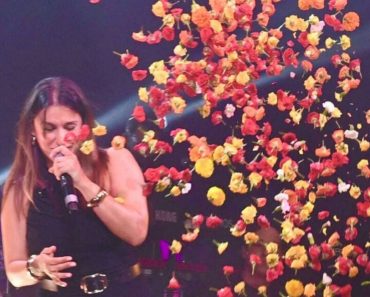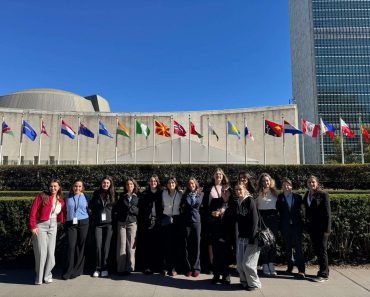By Madeleine Voth
NEW YORK, NY — October 11, 2025 — Through the doors of St. John’s Church in Greenwich Village, rich sounds of flutes and oboes could be heard as the Pana Hora Ensemble returned to the stage for the first time in over two years with a new performance entitled Winds, Words, and Blessings. Structured around the compositions of Charles Calomiris, Pana Hora brings a distinctly Greek sound to chamber music, blending classical structure with Mediterranean rhythms and timbres.
Calomiris began his musical journey as a child, taking bouzouki lessons from renowned musician Giannis Tatasopoulos, who at the time was living in Baltimore, Maryland, about two hours away from Calomiris’s home in Washington, D.C. “He would sit down across from me and play, and then tell me to play, and so I would just try to imitate what he was doing. Then I’d get home and try to remember it…it was really kind of an intense experience to just sit down with someone and them say, here’s what I’m going to show you today.” Around this same time, he was also learning composition and music theory in high school classes, but that was where his musical training ended. “That’s all. That was the only musical training I ever had.”
This early immersion in Greek folk music, and later training in composition and theory inspired Calomiris early on. Now, his compositions invite chamber musicians, often trained in Western classical traditions, to explore the phrasing, ornamentation, and storytelling of Greek and Mediterranean music through a modern lens.
Following Sunday’s performance, the musicians spoke about collaboration, culture, and passion through their involvement with Pana Hora. “We met Charles years ago, when he was just beginning to record his first compositions,” said Ginevra Petrucci, one of the ensemble’s founding members. “It started as a one-off collaboration that became a friendship based in the arts. Charles is a wonderful catalyst and a wonderful person. This grew organically into an ensemble, several records, and even an opera we’re working on next year.”
For many members, Pana Hora has not simply been centered within playing music, but has also become culturally enriching. While most of the performers are not Greek by background, they describe feeling “adopted” into the culture through Calomiris’s work. “Every one of these pieces is rooted in some element of Greek culture,” Ginevra said. “It could be a rhythm from a traditional dance, a literary or mythological reference, or even a religious one…Before we play or record, Charles gives us context so we understand what inspired the piece. And afterward, he usually takes us to a Greek restaurant and orders everything.”
Percussionist Oliver Xu added that his time with Pana Hora introduced him to entirely new instruments. “Playing Charles’s music was my first opportunity to play something Greek in style,” he said. “I actually learned the toubeleki just for his pieces…it’s this goblet-shaped drum that’s central in Mediterranean music, so that was a big part of the early few years with a group, was me getting to know this instrument.”
This kind of collaboration through cultural education sets Pana Hora apart from typical chamber groups. The ensemble’s performances often mix flutes, bassoon, and strings with hand percussion, creating a unique sound that borrows from both the ancient and modern Greek worlds. Their concerts also experiment with cross-cultural and cross-disciplinary elements, from French compositions to lectures and culinary pairings.
“Charles has so many ideas about collaboration, across cultures, and even across disciplines like food and poetry,” said Tylor Thomas, who plays bassoon. “He likes to find connections between different traditions. Sometimes he’ll, very humorously, combine two different dances, or something like that, to point out either exaggerations or commonalities, similarities between the dances or cultures.”
As for what they hope audiences take away, the musicians say it is less about technical mastery within the music but more about the relationships and passion that have been forged along the way. “We’ve played together for years, and I think that comes across in the music.” She continued, emphasizing Calomiris’s love for what he’s doing. “He puts a lot of heart and soul into his music and into this whole experience.” Thomas agreed: “Charles puts so much of himself into what he’s doing. He’s collaborative and open. We all hope that love and connection come through to the audience.”
As the ensemble looks ahead, they are making plans to expand even further. “This is something that we talk about a lot,” Thomas said, “how do we also include other cultures, other instruments, other traditions into what we do for Pana Hora? Pana Hora started as a very Greek-centered ensemble, but there is a desire to explore other similar cultures.” With this, the focus remains on bringing a more cross-cultural, inclusive experience to Pana Hora.
For Calomiris, that inclusivity is woven into the foundation of Greekness. “One of the most important concepts in Greek culture is philoxenia: love of foreign things, or the sort of wanting to share things and cross boundaries and be part of a world, a community.” he said. “That’s what we want the music to express. It’s something that’s a little bit lost. Maybe I’m missing it, but I don’t see it around me very much.
If you want to follow the progression of the ensemble, you can visit their website at panohoraensemble.com. Further, look out for information on their upcoming performance at Merkin Hall in the Kaufman Music Center in New York City, on March 20th and 21st, 2026.








